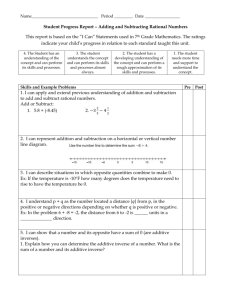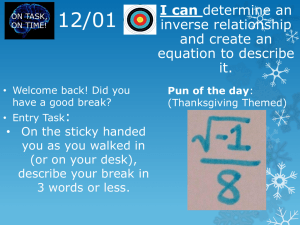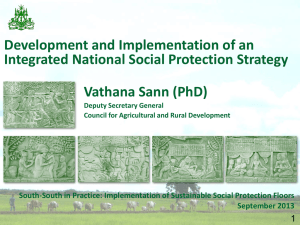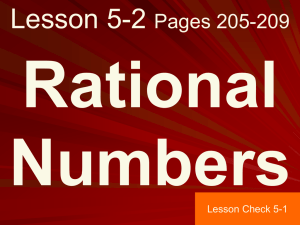7.NS.1_11_28_12_final
advertisement
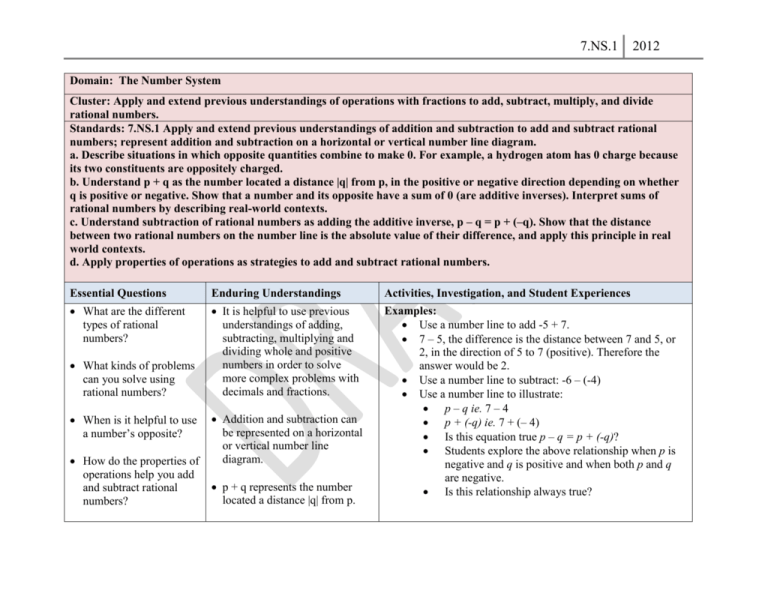
7.NS.1 2012 Domain: The Number System Cluster: Apply and extend previous understandings of operations with fractions to add, subtract, multiply, and divide rational numbers. Standards: 7.NS.1 Apply and extend previous understandings of addition and subtraction to add and subtract rational numbers; represent addition and subtraction on a horizontal or vertical number line diagram. a. Describe situations in which opposite quantities combine to make 0. For example, a hydrogen atom has 0 charge because its two constituents are oppositely charged. b. Understand p + q as the number located a distance |q| from p, in the positive or negative direction depending on whether q is positive or negative. Show that a number and its opposite have a sum of 0 (are additive inverses). Interpret sums of rational numbers by describing real-world contexts. c. Understand subtraction of rational numbers as adding the additive inverse, p – q = p + (–q). Show that the distance between two rational numbers on the number line is the absolute value of their difference, and apply this principle in real world contexts. d. Apply properties of operations as strategies to add and subtract rational numbers. Essential Questions Enduring Understandings Activities, Investigation, and Student Experiences What are the different types of rational numbers? It is helpful to use previous understandings of adding, subtracting, multiplying and dividing whole and positive numbers in order to solve more complex problems with decimals and fractions. Examples: Use a number line to add -5 + 7. 7 – 5, the difference is the distance between 7 and 5, or 2, in the direction of 5 to 7 (positive). Therefore the answer would be 2. Use a number line to subtract: -6 – (-4) Use a number line to illustrate: p – q ie. 7 – 4 p + (-q) ie. 7 + (– 4) Is this equation true p – q = p + (-q)? Students explore the above relationship when p is negative and q is positive and when both p and q are negative. Is this relationship always true? What kinds of problems can you solve using rational numbers? When is it helpful to use a number’s opposite? How do the properties of operations help you add and subtract rational numbers? Addition and subtraction can be represented on a horizontal or vertical number line diagram. p + q represents the number located a distance |q| from p. 7.NS.1 How does the opposite of a number differ from the absolute value of it? Content Statements Classify numbers. Find the absolute value of a number. Identify opposites. Find sums and differences of rational numbers in practice and real world context. Solve problems involving rational numbers using number lines, and the additive inverse. Identify and apply the Commutative, Associative, and Identity properties to simplify rational numbers. Find the distance between two rational numbers on the number line using the absolute Opposite quantities combine to make 0. 2012 Morgan has $4 and she needs to pay a friend $3. How much will Morgan have after paying her friend? Solution: 4 + (-3) = 1 or (-3) + 4 = 1 Number and its opposite have a sum of 0. (additive inverse) Subtraction of rational numbers means adding the additive inverse, p – q = p + (–q). Subtraction is really finding the distance between two numbers on a number line. Apply the Associative, Commutative, and Identity Properties to solve problems. Activities: Use algebra counters/tiles to model addition of integers. Use a number line to model addition of integers. Provide students with debits and credits for an account. Students should determine what values would be needed to “zero out an account.” Stock market: Give 5 stock values and their daily increases and decreases, students need to determine increased for following day to “break even” using appropriate signs. The lesson should be modeled on a number line. Temperature: Create a table of a city’s high and low temperatures for a week. Be mindful to choose a city whose temperatures include positive and negative numbers. Pair the students to answer questions such as “How much warmer is Sunday’s high temperature than Sunday’s low temperature? 7.NS.1 value of their difference. Assessments Last week, Jane made deposits of $64, $25, and $37 into her checking account. She then wrote checks for $52 and $49. What is the overall change in Jane’s account balance? A submarine submerges at a depth of -40ft dives 57ft more. What is the new depth of the submarine? At 3 P.M., the temperature was 9°F. By 11 PM, it had dropped 31°F. What was the temperature at 11 PM? 7(1/2 + ¾), -2(5 + ½), 7 ½ x 4/4, 3/2(1/8 + 2/16) Write a story that would result in the problem: (-3) + 6 + 5.7 - 8 2012 Which day has the greatest difference between its high and low temperatures?” Allow students to discover the process using whatever solution strategies make sense to them. Move onto larger number once students understand. Possible use Earth’s Highest and Lowest Elevations. Repeat with similar type questions. Ask students to develop a procedure for adding and subtracting rational numbers. Have them apply their procedures to several practice problems. Extend this concept to problems involving negative fractions and decimals. Have students investigate if the same procedures apply. Cards: Use a deck of cards. Assign values to the Ace, King, Queen, Jack. Have students play “war”. Evenly distribute the deck of cards within each group. Each students flips two cards and finds the sum. The student with the largest sum gets all the cards. Red cards are negative, black cards are positive. Model the solution in two different ways. Diminishing Return Part and Whole Distance: Generate a discussion about distance. Help students arrive at the idea that distance is always positive. Display a classroom number line. Ask questions such as, “What if your house was at 7 and your friends house was at 2, how would you find 7.NS.1 The height of Tom’s house from ground level to the top 7 of the roof is 23 ft. The basement floor of his house is 8 3 7 ft below ground level. Tom wrote this number 4 sentence to find the distance between the top of the roof and the basement floor: 23 7 3 – (- 7 ) = 4 8 What is the distance between the top of the roof and the basement floor? 5 1 1 5 A) 31 * B) 16 C) 16 D) 31 8 8 8 8 2012 the distance? Does the distance change if we start at 7 or start at 2? Could we find the distance by subtracting 7 from 2?” Introduce the concept of absolute value. Tell them that since the distance is the same regardless of direction, we use the absolute value symbols to indicate that what we are looking for the distance. Ask more questions such as “What if you lived at 2 and your grandmother lived at -8, how would you find the distance? How far away would you be from your grandmother? Is the distance from your house to your grandmother’s house, the same as the distance from your grandmother’s house to yours?” Emphasize they can count the number of spaces or express it as |-82|or |2-(-8)|. Divide the students into pairs, provide each group with a worksheet of different distances or altitudes, have the students select and answer one problem then share out with the class. Card Values: Use a deck of cards. Assign values to the Ace, King, Queen, Jack. Have students play “war”. Evenly distribute the deck of cards within each group. Each students flips two cards and finds the difference. The student with the largest sum gets all the cards. Red cards are negative, black cards are positive. 7.NS.1 2012 Examples of 7.NS.1 Comparing Freezing Points Distances on the Number Line 2 Operations on the Number Line grade 7 addition subraction rational numbers.doc Equipment Needed: Teacher Resources: Interactive Whiteboard http://www.illustrativemathematics.org/standards/k8 Calculators http://insidemathematics.org/index.php/7th-grade Stocks Deck of Cards Algebra counters Vertical Number lines Horizontal number lines http://www.nyscirs.org/CCSS%20Toolkit/Math%20Toolkit/ Exemplars/ http://www.schools.utah.gov/CURR/mathsec/Core/7thGrade-Core/7NS.aspx http://www.ncpublicschools.org/acre/standards/commoncore-tools/ http://illuminations.nctm.org/
